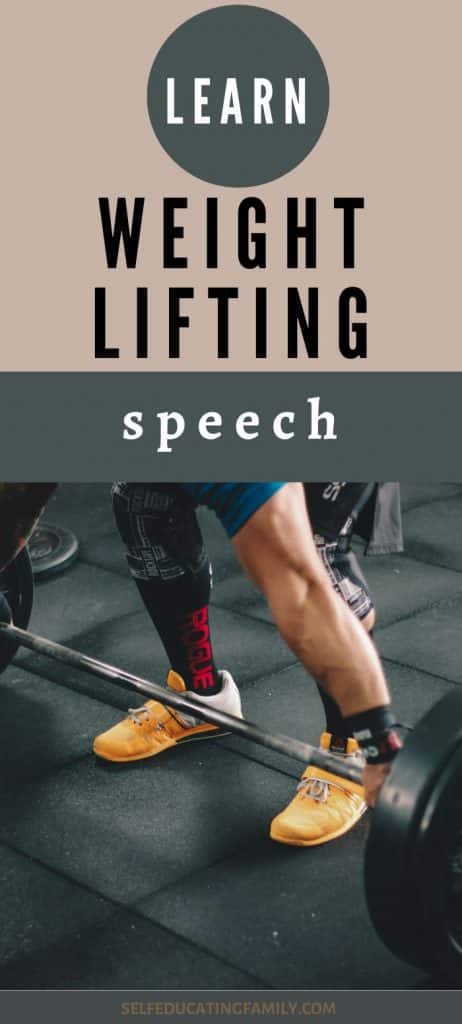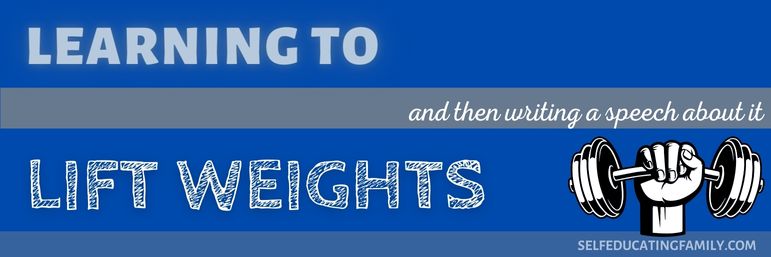Should you learn weightlifting? My son decided to learn everything he could about lifting weights. And then he became a proponent of weightlifting and convinced his two brothers to lift. I tried to learn a few times, but I guess I need more supervision apparently because I lack proper form and keep straining muscles.
The down-side of teaching your kids to be self-learners
One of the interesting side effects of being a homeschool mom is watching your kids learn and become extremely good at subjects you never would have predicted. And that you know nothing about! That’s what I get for teaching them to be self-learners.
When one of my sons decided to learn to lift weights, it made me a bit nervous, especially as he pushed his limits. The sheer weight that he lifted was unnerving. Especially when your teen starts squatting over 400 pounds.
So I made sure he learned from people who really knew what they were doing and that he took all the safety measures that were proper.
Meanwhile
Meanwhile, as he got better at lifting weights, he became more excited about sharing it with others. Which brings us to speech club.
In our speech club, Speech 3 was called “Getting to the Point”. The purpose was to outline your speech on a topic you knew a lot about and make sure your point was clear and supported.
So here’s a look at my son’s Speech 3 about weightlifting. I’ve added notes to show how he outlined the topic and supported his points.
Outline & text of Speech 3
Title
The Joys of Moving Large Chunks of Metal with Various Parts of your Body a.k.a. Weightlifting
Note: Always use a catchy title, preferably one that has a surprise re-use at the end of the speech.
I. Intro
Who wants to be in better shape? Everyone right?
I mean who here thinks, “I don’t ever want to be any more athletic than I am right now.” NOBODY, that’s who. Everyone wants lose fat, get stronger, get faster, whatever.
But what’s the best way to do that? Take steroids.
Just kidding it’s not… well actually, it is, but unless you’re brain-damaged, you can figure out that huge biceps are not worth major health issues which kill you by age 45.
So if steroids aren’t the answer, what is?
I believe it’s weightlifting.
Note: Good opening — contains a question, humor, an emotional hook, attention-getting statements, and leads right into his specific purpose: Weightlifting is the best form of exercise.
II. Versatility of weightlifting
Supporting Point 1: Can help with strength, speed, endurance
Weightlifting is very powerful primarily because of its adaptability. With only a bar, some weight plates, and a few dumbbells you can train for just about anything.
Weightlifting is known for making you stronger, but by using the explosive “Olympic lifts” you can also get faster. Over the past year, I cut my time in the 100-meter dash by a full second. I can’t be certain that weightlifting was the reason, but I started weightlifting about ten months ago. And I’ve focused a lot on the Olympic lifts.
Coincidence? I think not!
Weightlifting can even help with stamina. By doing high repetitions you can greatly increase your endurance.
Supporting Point 2: Can help you lose weight
Like any type of physical activity, weightlifting can help you lose weight. But conversely…
Supporting Point 3: Can help you gain weight
One thing weightlifting helps you do better than just about anything else is gaining weight. This may not be something you would think about, but being super skinny can be a big problem, especially if you play any kind of sport.
Weightlifting is known for bulking people up, and putting on twenty pounds of muscle through weightlifting is bound to be healthier than stuffing yourself with Doritos and soda.
Supporting Point 4: It’s safe
Note: I liked this point.
Contrary to what you might expect weightlifting is one of the safest forms of physical activity. In a study on injuries in school sports, competitive weightlifting, and weight training came in dead last in the number of injuries, with 0.0017 and 0.0035 injuries per 100 hours respectively.
Compare this to the injury leader in that study: soccer, with 6.2 injuries per 100 hours. You’d probably never think twice about playing soccer, but you’re about 2500 times more likely to hurt yourself playing soccer than lifting weights.
III. Comparisons with other forms of physical activity
I think I’ve shown that Weightlifting is an effective form of exercise, but how does it compare to some other popular types of exercise?
Walking/jogging
- both good, but high impact can prove problematic for legs down the road. Also no upper body work.
Let’s start with walking.
Weightlifting wins because walking is for wimps.
Just kidding, but just walking has huge limitations, after a certain point it doesn’t really do much for you.
Bicycling
- No high impact, but no upper body work
How about bicycling? Bicycling is definitely more of an athletic activity than walking.
The only problem with bicycling is it ignores half your body.
Weightlifting wins over bicycling, because weightlifting can train all the muscles in your body, bicycling only trains your legs, though it does an effective job of it.
Calisthenics/ body weight exercises
- Best next to weight lifting, but
- Can’t train some muscles as well, the biggest one being the back
- Not as adaptable as weights, with no increased resistance only increased reps so more focus on endurance
- Much harder for older people, and people with joint problems/ injuries
Finally calisthenics or bodyweight exercises. Calisthenics is almost certainly the strongest alternative to weightlifting that I’ve presented but I think weightlifting still wins out, here’s why.
Most of the movements of calisthenics can be duplicated with weights, this gives weightlifting an advantage because you can quickly adjust the resistance you’re using. With calisthenics, you’re more or less stuck with your body weight. Also because of its body-intensive nature, significant injuries and joint problems make calisthenics much more difficult than they do weightlifting.
IV. Conclusion
Weightlifting is one of the best forms of exercise
- Helps with basically any kind of physical activity
- Keeps you healthy
- Is very accessible for all ages, and experiences, and even for people with injuries/ issues which prevent them from doing other kinds of exercise.
Weightlifting is one of the best ways to exercise and train. It can help with almost any activity that requires movement. And it is actually safer and less injury prone than most other athletic activities. In my opinion, which is equivalent to scientific fact.
Weightlifting is all around better than other exercises. If you are physically able to lift large chunks of metal with your body, you should be doing it yesterday.
Note: Always end on a high note, leaving the audience with a way to remember your point.
End of Speech
Were you convinced?
Altogether, a fun persuasive speech, that highlighted the stuff he earned about lifting weights. It made me consider trying it. A few times. Maybe I’ll even get good enough to learn how to do it safely someday.
Keep Learning
For more posts on learning public speaking in high school:
- How to Start a Speech Club
- Speechcraft: Learning to use Words Effectively sample speech
- How to Assess High School Credit for Speech club
- Back to Homeschool Speech example
- Skills Win out Over Passion example speech
For more information on speaking and weightlifting:
- Six Minutes Toastmasters Speech 3: Get to the Point
- Rogue Fitness: How to Strongman Log Press
- Barbell Medicine: The Beginner Prescription
And if you’d rather start slowly by just working out at home, check out the encouragement at ShapelyWays.

